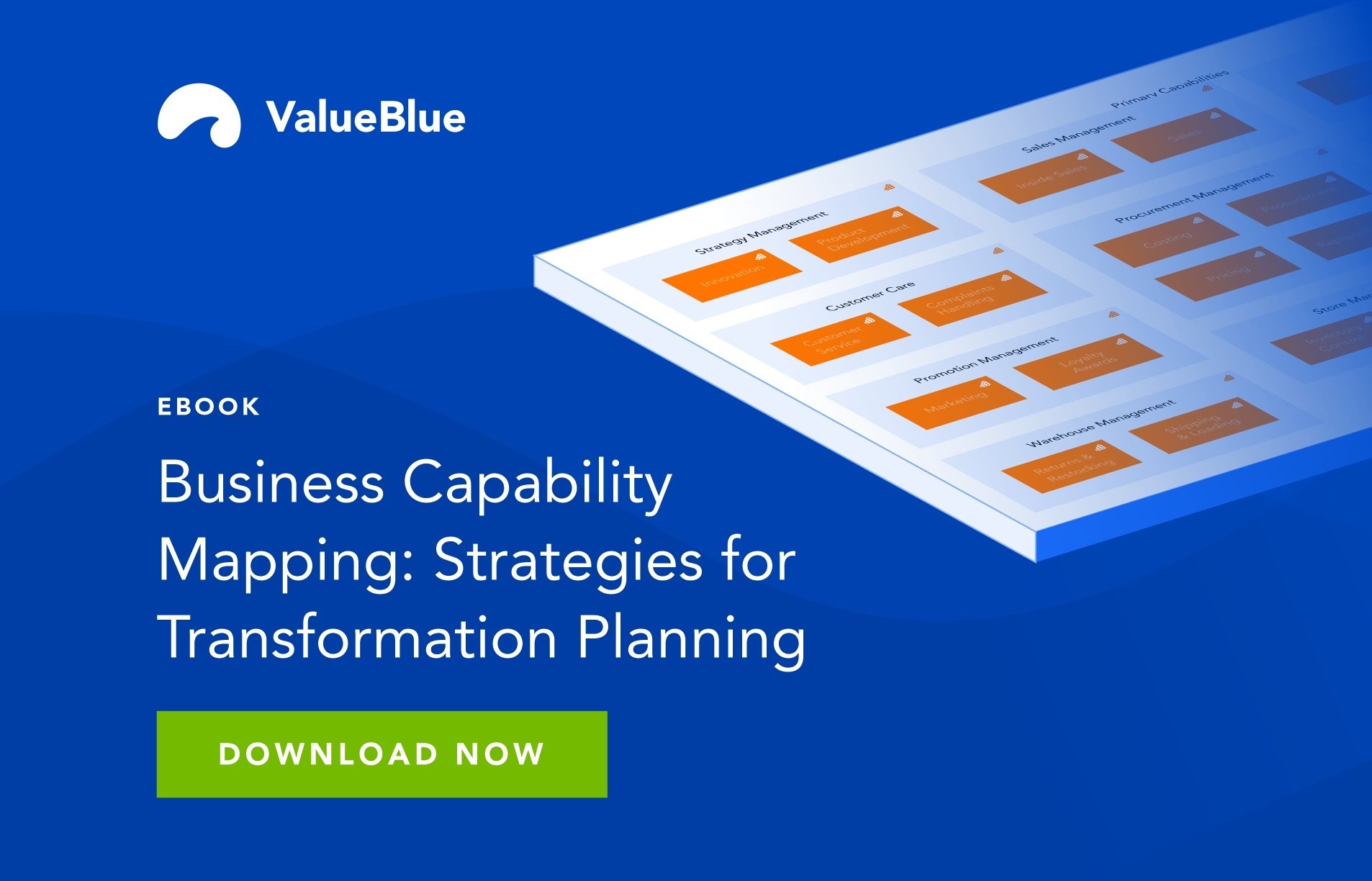Business Agility in Higher Ed Using Business Capability Modelling
In one of our previous blogs, we introduced a guided approach to tackling business transformation. One technique commonly used for impact analysis and subsequent prioritization is Business Capability Modelling.
Before exploring the details, it is important to understand Business Capability Modelling. Many specific transformation use cases can naturally be supported, but in this blog, we focus on digitizing the customer (student) journey.
What is Business Capability Modelling
Business Capability Modelling is a strategic approach used in Architecture Modelling to define, analyze, and manage an organization's capabilities. A capability represents an organization's ability to perform a specific function or activity necessary to achieve its goals. This approach involves identifying and documenting the various capabilities, understanding their relationships, and aligning them with the overall business strategy.
In the context of customer journey digitization, Capability Modelling helps organizations map out the capabilities required to deliver seamless and optimized customer experiences. By doing so, businesses can identify gaps, streamline processes, and ensure that all technological and operational elements are aligned to support the customer journey. This holistic view enables better decision-making and resource allocation and ultimately enhances customer satisfaction and loyalty.
Benefits of Business Capability Modeling for higher ed
Leading universities worldwide have adopted Enterprise Architecture as a practice in their organizations. In most cases, Architecture teams work alongside IT teams to drive improvements in the Business IT solutions used by students and employees.
In recent years, Business Capability thinking has become more prominent in the higher education industry community. Some universities have tried to adopt capability thinking in their Enterprise Architecture practices and created Capability Models for their organizations backed by an architecture repository.
Some practical benefits of using this technique include the following:
- A shared view of the organization. In some cases, the Capability Model is the main starting point for navigating the architecture for all organizational stakeholders. It provides a high-level, unambiguous view of everything the organization does or performs, which helps segment the total Enterprise Architecture properly and effectively.
- Enabling business transformation. The capability architecture can be modeled for each capability, showing which architecture components support its delivery. For example, the ‘Enrolment’ capability would be delivered through:
- Business processes: Application submission, Eligibility evaluation, Fee payment, Student verification
- Applications: Student information system, CRM, Payment gateway, Course registration portal (and, of course, vendor-specific implementations)
- Data: Personal information such as name, date of birth, and contact details; Academic records (grades, transcripts); Payment data
In this way, current and future state modeling can be done for a capability, supporting the organization's business transformation initiatives to make these individual capabilities more effective and efficient with a lower risk of failure.
- Support strategic discussions. The capability model can serve as a vehicle for high-level strategic discussions about the university's activities. For each Business Capability, the strategic importance and (current and future) operational maturity can be discussed and agreed upon.
When senior management agrees on key capabilities' strategic importance and maturity, the capability model can provide valuable insights. For example: What are the most important capabilities we think are currently at low maturity? Do we need to start improvement initiatives for these capabilities that have been identified and create recommendations for improvements?
Reducing the lift: Business Capability Modeling reference models
For educational institutions, especially those with limited experience in Enterprise Architecture, distilling all the organization's insights and data into something practical and usable can be daunting. Rather than creating something from scratch, reference models can provide a solid foundation for getting things off the ground.
Architecture Reference Models are essential tools in Enterprise Architecture modeling. They provide standardized frameworks to describe and analyze an organization's various components and relationships. These models enable organizations to manage their IT resources better, streamline processes, and support strategic decision-making.
Organizations can use reference models to ensure consistency and alignment with industry best practices (e.g., DODAF in defense) and regulatory requirements. They help identify gaps, redundancies, and opportunities for improvement within the Enterprise Architecture. For instance, the TOGAF framework includes several reference models, such as the Technical Reference Model (TRM) and the Business Reference Model (BRM), which guide the development and management of IT portfolios.
These models enable organizations to manage their IT resources better, streamline processes, and support strategic decision-making. Overall, Architecture Reference Models play a crucial role in achieving a coherent and efficient Enterprise Architecture.
A higher ed-specific asset: the HERM model
The Higher Education Reference Model (HERM) provides standardized business, data, application, and technology architectures that offer a generalized view of how higher education institutions are organized and the information they use.
Developed by the CAUDIT Enterprise Architecture Community of Practice, HERM is designed to support scenario-based planning and strategic decision-making within higher education institutions.
It is a valuable tool for accelerating digital transformation, enhancing interoperability, and facilitating collaboration among institutions. By using HERM, universities can improve the efficiency of their architecture teams, describe a comprehensive view of their operations, and engage stakeholders effectively. The model is widely adopted globally, helping institutions to align their IT resources with their strategic goals and improve overall institutional performance.
Business Capability Model built: What is the next step?
Once the capability model is captured as structured data, the next logical step is to visualize it (e.g., with heatmaps or dashboards). This helps stimulate cross-domain and cross-departmental discussions on how things are currently done in the organization and how effectively they're being executed.
Tying the capability model to Project Portfolio data takes you one step further in providing transparency around what is being delivered and ensuring it relates to strategic direction.
With these links established, the following questions can be answered: Are we currently running projects to improve capabilities that are not strategic for the organization? Does it make sense? By doing so, we are closing the loop between strategy and execution.
Conclusion
Adopting Enterprise Architecture and Capability Modeling in higher education helps universities align IT resources with academic and administrative goals. Universities leading with Business Capability modeling demonstrate how these methods drive improvements, foster collaboration, and support business transformation. By linking capability models to project data, universities can align efforts with strategic priorities, improving performance and reducing risk. These practices are crucial for navigating the digital age and ensuring long-term success.
In the final blog in this series, we’ll examine the business process dimension of transformation support. Stay tuned!
.png)


